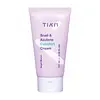What's inside
What's inside
 Key Ingredients
Key Ingredients

 Benefits
Benefits

 Concerns
Concerns

 Ingredients Side-by-side
Ingredients Side-by-side

Water
Skin ConditioningGlycereth-26
HumectantButylene Glycol
HumectantDipropylene Glycol
Humectant1,2-Hexanediol
Skin ConditioningPropanediol
SolventGlycerin
HumectantC12-14 Pareth-12
EmulsifyingBetaine
HumectantAllantoin
Skin ConditioningCarbomer
Emulsion StabilisingLeontopodium Alpinum Callus Culture Extract
AntioxidantSaccharomyces/Rice Ferment Filtrate
Skin ConditioningLactobacillus Ferment
Skin ConditioningLactobacillus/Pear Juice Ferment Filtrate
Skin ConditioningLactobacillus/Punica Granatum Fruit Ferment Extract
Skin ConditioningLactobacillus/Soybean Ferment Extract
Skin ConditioningSaccharomyces/Barley Seed Ferment Filtrate
HumectantLactococcus Ferment
Skin ConditioningChondrus Crispus Extract
Skin ConditioningJania Rubens Extract
Skin ConditioningAnemarrhena Asphodeloides Root Extract
Skin ConditioningHydrolyzed Collagen
EmollientHydrolyzed Elastin
EmollientSodium Hyaluronate
HumectantDipotassium Glycyrrhizate
HumectantXanthan Gum
EmulsifyingHydrogenated Polyisobutene
EmollientAdenosine
Skin ConditioningTocopherol
AntioxidantArginine
MaskingCopper Tripeptide-1
Skin ConditioningAcetyl Hexapeptide-8
HumectantPalmitoyl Pentapeptide-4
Skin ConditioningPalmitoyl Tetrapeptide-7
Skin ConditioningPalmitoyl Tripeptide-1
Skin ConditioningEthylhexylglycerin
Skin ConditioningDisodium EDTA
Parfum
MaskingWater, Glycereth-26, Butylene Glycol, Dipropylene Glycol, 1,2-Hexanediol, Propanediol, Glycerin, C12-14 Pareth-12, Betaine, Allantoin, Carbomer, Leontopodium Alpinum Callus Culture Extract, Saccharomyces/Rice Ferment Filtrate, Lactobacillus Ferment, Lactobacillus/Pear Juice Ferment Filtrate, Lactobacillus/Punica Granatum Fruit Ferment Extract, Lactobacillus/Soybean Ferment Extract, Saccharomyces/Barley Seed Ferment Filtrate, Lactococcus Ferment, Chondrus Crispus Extract, Jania Rubens Extract, Anemarrhena Asphodeloides Root Extract, Hydrolyzed Collagen, Hydrolyzed Elastin, Sodium Hyaluronate, Dipotassium Glycyrrhizate, Xanthan Gum, Hydrogenated Polyisobutene, Adenosine, Tocopherol, Arginine, Copper Tripeptide-1, Acetyl Hexapeptide-8, Palmitoyl Pentapeptide-4, Palmitoyl Tetrapeptide-7, Palmitoyl Tripeptide-1, Ethylhexylglycerin, Disodium EDTA, Parfum
Snail Secretion Filtrate 92%
Skin ConditioningCetearyl Olivate
Sorbitan Olivate
EmulsifyingCaprylic/Capric Triglyceride
MaskingButylene Glycol
HumectantCetearyl Alcohol
EmollientBetaine
HumectantDimethicone
EmollientCarbomer
Emulsion StabilisingEthyl Hexanediol
SolventPhenoxyethanol
PreservativeAllantoin
Skin ConditioningArginine
MaskingSodium Polyacrylate
AbsorbentSodium Hyaluronate
HumectantPanthenol
Skin ConditioningXanthan Gum
EmulsifyingAdenosine
Skin ConditioningPalmitic Acid
EmollientStearic Acid
CleansingWater
Skin ConditioningSodium Guaiazulene Sulfonate
Snail Secretion Filtrate 92%, Cetearyl Olivate, Sorbitan Olivate, Caprylic/Capric Triglyceride, Butylene Glycol, Cetearyl Alcohol, Betaine, Dimethicone, Carbomer, Ethyl Hexanediol, Phenoxyethanol, Allantoin, Arginine, Sodium Polyacrylate, Sodium Hyaluronate, Panthenol, Xanthan Gum, Adenosine, Palmitic Acid, Stearic Acid, Water, Sodium Guaiazulene Sulfonate
Ingredients Explained
These ingredients are found in both products.
Ingredients higher up in an ingredient list are typically present in a larger amount.
Adenosine is in every living organism. It is one of four components in nucleic acids that helps store our DNA.
Adenosine has many benefits when used. These benefits include hydrating the skin, smoothing skin, and reducing wrinkles. Once applied, adenosine increases collagen production. It also helps with improving firmness and tissue repair.
Studies have found adenosine may also help with wound healing.
In skincare products, Adenosine is usually derived from yeast.
Learn more about AdenosineAllantoin is a soothing ingredient known for its protective and moisturizingg properties. Because of this, it is often added to products with strong active ingredients.
Studies show higher concentrations of this ingredient can promote wound healing.
Though it can be derived from the comfrey plant, allantoin is produced synthetically for cosmetic products to ensure purity.
Learn more about AllantoinArginine is an amino acid that is important for human development. Your body uses is it to produce hair keratin and skin collagen.
As a cosmetic ingredient, Arginine has antioxidant properties and can also help repair damaged skin. This ingredient is derived either synthetically or from animals.
Arginine isn't fungal acne safe when used in the presence of other lipids (fats, fatty acids, oils, esters, etc). Oils and fats occur naturally within the skin, so take caution when using Arginine if you're prone to fungal acne.
Learn more about ArginineBetaine is a common humectant (a substance that promotes retention of moisture). It's known to be gentle on the skin and can help balance hydration.
This ingredient is best for improving hydration and soothing irritated skin. Studies also show it helps even out skin tone.
Fun fact: Betaine is naturally created in the skin and body. The kind found within cosmetic products can be either plant-derived or synthetic.
Another name for betaine is trimethylglycine.
Learn more about BetaineButylene Glycol (or BG) is used within cosmetic products for a few different reasons:
Overall, Butylene Glycol is a safe and well-rounded ingredient that works well with other ingredients.
Though this ingredient works well with most skin types, some people with sensitive skin may experience a reaction such as allergic rashes, closed comedones, or itchiness.
Learn more about Butylene GlycolCarbomer is a polymer of acrylic acid. Its main role is to create a gel consistency.
A high amount of carbomer can cause pilling or balling up of products. Don't worry, most products contain 1% or less of carbomer.
Sodium Hyaluronate is hyaluronic acid's salt form. It is commonly derived from the sodium salt of hyaluronic acid.
Like hyaluronic acid, it is great at holding water and acts as a humectant. This makes it a great skin hydrating ingredient.
Sodium Hyaluronate is naturally occurring in our bodies and is mostly found in eye fluid and joints.
These are some other common types of Hyaluronic Acid:
Learn more about Sodium HyaluronateWater. It's the most common cosmetic ingredient of all. You'll usually see it at the top of ingredient lists, meaning that it makes up the largest part of the product.
So why is it so popular? Water most often acts as a solvent - this means that it helps dissolve other ingredients into the formulation.
You'll also recognize water as that liquid we all need to stay alive. If you see this, drink a glass of water. Stay hydrated!
Learn more about WaterXanthan gum is used as a stabilizer and thickener within cosmetic products. It helps give products a sticky, thick feeling - preventing them from being too runny.
On the technical side of things, xanthan gum is a polysaccharide - a combination consisting of multiple sugar molecules bonded together.
Xanthan gum is a pretty common and great ingredient. It is a natural, non-toxic, non-irritating ingredient that is also commonly used in food products.
Learn more about Xanthan Gum